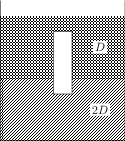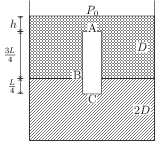Buoyancy
Consider an object of mass $m$, volume $V_o$ and density $\rho_o$. This object is immersed in a liquid of density $\rho_l$. The buoyant force on the object is equal to the weight of the liquid displaced by the object. If the object displace liquid volume $V_l$ then upthrust (buoyant force) on the liquid is given by \begin{align} F_b=\rho_l V_l g. \end{align}
The object will sink if buoyant force on it is less than its weight. The buoyant force on the object is equal to the net upward force on it due to liquid pressure.
For simplicity, let object is a cylinder of length $h_o$ and cross-sectional area $A$. The buoyant force on it when its length $h_\text{sub}$ is submerged in the liquid is \begin{align} F_b=\rho_l A g h_\text{sub} \end{align} The buoyant force increases linearly with the submerged length. The buoyant force is maximum when it is fully submerged in the liquid. The object floats if $F_b=mg$ for a value of $h_\text{sub} < h_o$.
Problems from IIT JEE
Problem (IIT JEE 1995): A homogeneous solid cylinder of length $L$ and cross-sectional area $A/5$ is immersed such that it floats with its axis vertical at the liquid-liquid interface with length $L/4$ in the denser liquid as shown in the figure. The lower density liquid is open to atmosphere having pressure $P_0$. Then, density $D$ of solid is given by,

- $\frac{5}{4}d$
- $\frac{4}{5}d$
- $4d$
- $\frac{d}{5}$
Solution: Let A be the topmost point of the cylinder, B be the point on the interface, and C be the lowest point of the cylinder. Let the depth of point A be $h$. The pressures at A, B and C are,
\begin{align} &P_A=P_0+hdg, \\ &P_B=P_A+\tfrac{3}{4}Ldg,\\ &P_C=P_B+\tfrac{L}{4}(2d)g\!=\!P_A+\tfrac{5}{4}Ldg. \end{align}
The forces on the cylinder are its weight $W=D (LA/5) g$ (downwards), hydrostatic force at the top surface $F_A=P_A (A/5)$ (downwards), and hydrostatic force at the bottom surface $F_C=P_C (A/5)$ (upwards). In equilibrium, $F_A+W=F_C$ i.e., \begin{align} \label{bkb:eqn:4} P_A A/5+D (LA/5) g=(P_A+\tfrac{5}{4}Ldg) A/5. \end{align} Simplify above equation to get $D={5d}/{4}$.
